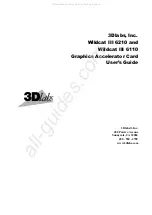
|
Glossary
41
|
ELSA GLADIAC 5II
|
EN
쎲
RAMDAC –
On a graphics board, RAM-
DAC is responsible for converting digital
signals into analog signals. VGA monitors
can only process analog signals.
쎲
RealColor –
In general, stands for a 15
or 16-bit-per-pixel-wide graphic display
mode (32,768 or 65,536 colors).
쎲
Refresh rate –
Indicates (in Hz) how of-
ten the image on the monitor is rebuilt per
second.
쎲
Rendering –
The calculative process for
representing 3D scenery, where position
and color are determined for each point in
space. The depth data are located in the
while the color and size data
are in the
쎲
Resolution –
The number of pixels in
both horizontal and vertical directions (e.g.
640 horizontal x 480 vertical pixels).
쎲
RGB –
Color data stored in red/green/
blue format.
쎲
ROM –
Abbreviation for Read Only Mem-
ory. Solid state memory that can be read
from only.
쎲
S-video –
Or S-VHS. A method of trans-
ferring video data signals, where the sig-
nals for
are separated. This results in im-
proved image quality.
쎲
SDRAM –
Synchronous Dynamic Random
Access Memory. These memory chips are
based on standard DRAMs (
but are fast enough to permit data access
at the clock speed of the
.
This eliminates the wait states typical of
DRAMs. They consist of two separate
memory ranges, with one preparing data
for access while the other is actually still
being accessed.
쎲
Shading –
The shading of curved areas
to make them appear as realistic as possi-
ble. To do so, the curved areas are divided
into many small triangles. The three most
important 3D shading methods differ by
how the color gradients within the trian-
gles are represented: Flat shading: The tri-
angles are colored uniformly. Gouraud
shading: The color gradient is determined
by the interpolation of the corner color val-
ues. Phong shading: The color gradient is
determined by the interpolation of the nor-
mal vector plus the calculation of the light
incidence for each pixel. These shading
methods are not supported directly in the
standard OpenGL API.
쎲
Single buffer –
Unlike the
, where there is doubled display
memory, single buffer mode does not al-
low access to the next prepared image,
resulting in animation that is not smooth.
쎲
Sphere environment mapping –
.
쎲
Stencil buffer –
This buffer permits the
color information of the
to be sup-
plemented with further information. This
can be used to create stencils, volumetric
shadows and reflective surfaces, for ex-
ample.
쎲
Strips and fans –
Process for the reduc-
tion of data volume required for complex
3D objects. Strips are used for objects con-
sisting of several parallel rows of trian-
gles. Rather than calculating each indivi-






































